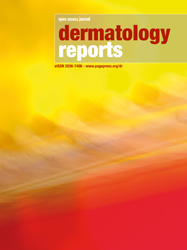Agreement on classification of clinical photographs of pigmentary lesions: exercise after a training course with young dermatologists

All claims expressed in this article are solely those of the authors and do not necessarily represent those of their affiliated organizations, or those of the publisher, the editors and the reviewers. Any product that may be evaluated in this article or claim that may be made by its manufacturer is not guaranteed or endorsed by the publisher.
Authors
Smartphone apps may help promoting the early diagnosis of melanoma. The reliability of specialist judgment on lesions should be assessed. Hereby, we evaluated the agreement of 6 young dermatologists, after a specific training. Clinical judgment was evaluated during 2 online sessions, 1 month apart, on a series of 45 pigmentary lesions. Lesions were classified as highly suspicious, suspicious, non-suspicious or not assessable. Cohen’s and Fleiss’ kappa were used to calculate intra- and inter-rater agreement. The overall intra-rater agreement was 0.42 (95% confidence interval - CI: 0.33-0.50), varying between 0.12-0.59 on single raters. The inter-rater agreement during the first phase was 0.29 (95% CI: 0.24-0.34). When considering the agreement for each category of judgment, kappa varied from 0.19 for not assessable to 0.48 for highly suspicious lesions. Similar results were obtained in the second exercise. The study showed a less than satisfactory agreement among young dermatologists. Our data point to the need for improving the reliability of the clinical diagnoses of melanoma especially when assessing small lesions and when dealing with thin melanomas at a population level.
How to Cite

This work is licensed under a Creative Commons Attribution-NonCommercial 4.0 International License.








